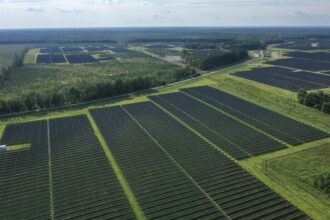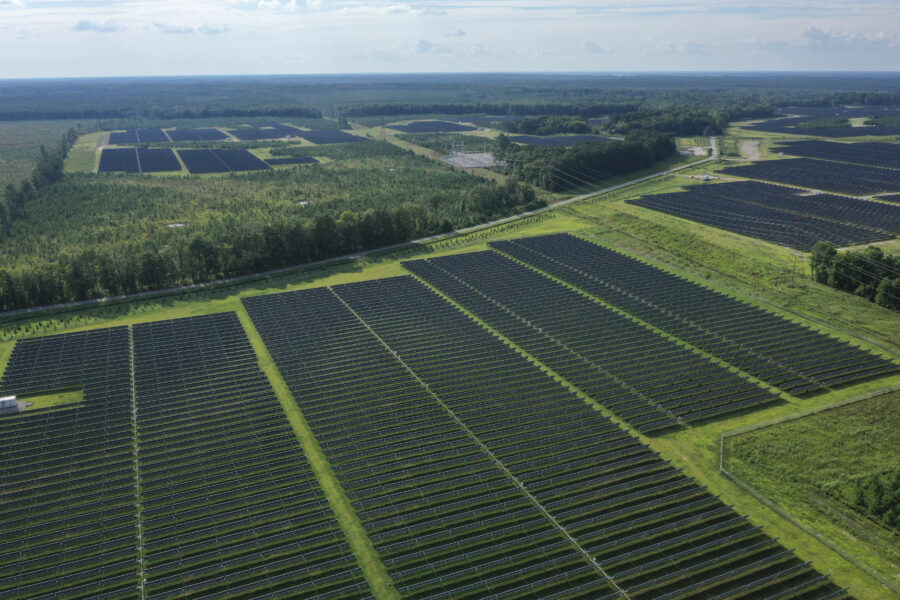It’s only a matter of time before Arizona identifies its first case of white-nose syndrome and the disease that has killed millions of bats in the U.S. spreads throughout the Sonoran Desert. But, in the meantime, the biggest threat to bat populations in the Southwest is wind turbines.
Roughly half a million bats die each year from wind turbine collisions. Just flying close to the wind turbines can be fatal—a blade slicing nearby creates enough air pressure to kill a bat that it doesn’t strike. The 2023 State of the Bats report predicts that four bat species in the U.S. could lose more than half of their population due to wind energy facilities in the next 15 years if no mitigation measures are taken.
While bird deaths have long been cited as a drawback of wind power, the turbine’s impacts on bats could have much larger environmental impacts.
Possibly the world’s most misunderstood creatures, bats are often portrayed as bloodthirsty, rabies-filled rats with wings, which is likely why humans were their main cause of death before 2000.
Yet more than one in five of earth’s mammals are bats, which have 1,400 species that can be found on every continent except Antarctica. Between pollination, seed dispersal and pest control, bats are an integral part of balancing ecosystems all over the globe.
“They’re providing these services we sort of take for granted,” said Jennifer Smith-Castro, the white-nose syndrome coordinator for the Southwest at the U.S. Fish and Wildlife Service. “When people realize the magnitude of it, it’s pretty impressive.”
It is difficult to study bats. For example, the greater mastiff bat—the largest bat in Arizona—lives in fissures at least 20 feet up cliff faces. Though researchers can use methods like acoustic monitoring to track down the bats, the work is arduous and it is still difficult to properly estimate the number of individuals on a particular site due to their dispersed and hard-to-reach living conditions.
“We wouldn’t know if they were having a hard time,” Smith-Castro said. “Maybe we should protect them for that reason.”
But there are more obvious reasons to reduce bat deaths.
The Sonoran Desert is particularly reliant on its bats. Covering more than 100,000 square miles of southwest California, Arizona and Mexico’s northern Sonora and Baja California, it has been called the most ecologically diverse desert in North America in both flora and fauna. Approximately 70 species of bats live in the Sonoran Desert. Arizona alone is home to 28 species, second only to Texas in bat diversity in the U.S. Throughout the desert, the winged mammals are crucial for the reproduction and survival of iconic plants like the region’s giant saguaro cactus and the agave that makes tequila.
But the desert’s bats are increasingly facing pressures that have been killing those in other regions for years, putting the Southwest’s plants and crops in peril as well.
A Fast Decline
Bat populations nationwide have been in steep decline for decades, largely due to white-nose syndrome, an incredibly contagious fungal disease that thrives in the cold. It targets bats during hibernation, when thousands of them huddle close together and their immune systems are weaker. It has been known to wipe out entire colonies in one winter. Some species, like the Northern Long-eared bat, which can be found in 37 states and eight provinces in North America, have seen population declines of 99 percent due to white-nose syndrome.
Forty states have confirmed cases of the disease, including Colorado and New Mexico, but so far white-nose syndrome hasn’t arrived in their neighbor, Arizona. Different bat behaviors specific to the Southwest may have prevented the disease’s spread there. Bats in the Sonoran Desert have shorter hibernations and are often dispersed in their roosts. There also is evidence that some bat species in the Southwest may be less likely to succumb to the disease, said Smith-Castro.
While it may not be as deadly in the desert, Smith-Castro said it is important to recognize that there is still a big risk.
“We don’t think (the Mexican free-tailed bats) are vulnerable at all to white-nose syndrome because they aren’t true hibernators, but we have concerns about them spreading the fungus around, because they can get it on them.”
And there are still times in Arizona when the conditions are just right for the fungus to thrive. But white-nose syndrome isn’t the only growing menace to bats in the state. Studies show that one of the biggest threats facing bats in the Southwest is wind energy facilities, which have already decimated some populations elsewhere in the country.
Before 2000, collisions with wind turbines accounted for only 3 percent of bat mortalities in the U.S., but that ratio rose to 35 percent in the following decades. Today, the only thing more deadly to bats than wind turbines is white-nose syndrome. The drastic change in fatality rates coincides with a substantial increase in the number of wind turbines in the U.S. There were 4,675 wind turbines constructed from 1980 to 1999, but that number surged to 58,888 between 2000 and 2021.
To produce as much energy as possible, turbines are being designed to take advantage of lower and lower wind speeds, so a wider range of locations will have appropriate wind speeds for windmills, but less of the sky will be safe for bats and birds.
Small Wind Farm With a Big Impact
There is only one small wind facility with 15 turbines in southern Arizona: Red Horse II. This location has been scrutinized over the years because of its high mortality rate for several migrating bird and bat species. The number of bat deaths per megawatt of energy produced is the highest in the state, and also high compared to other locations of its size across the nation, said bat management coordinator at the Arizona Game and Fish Department (AZGFD) Angela McIntire.
They have since implemented a deterrent that uses acoustics to steer bats away, but few studies have been performed to determine whether or not it has been effective. While it is good to pressure the companies contributing to the problem, there must be follow-up to ensure the solutions are indeed successful, McIntire said.
Some of the most obvious mitigations of wind turbines’ impacts on bats occur before they are built, by strategically siting wind energy facilities away from the paths of migrating bats and their preferred habitats. Still, experts find that the turbines seem to kill bats no matter what and believe more emphasis should be put on the continual post-construction mitigations than pre-construction education and decision making.
But some species are more interested, and perhaps even attracted, to wind turbines or the acoustic deterrents, National Renewable Energy Laboratory’s (NREL) Cris Hein said.
“We’ve seen deterrence work for bats for some species in some locations,” he said. “And then, in worst case scenarios, we’ve seen a slight increase in fatalities when the deterrnets are used.”
Hein said NREL is in the early stages of testing and validating a high frequency acoustic deterrent that can be placed on the tips of the blades in order for sound to travel farther out from the turbine. But to deliver higher frequency sounds reaching a farther distance is a difficult task.
Hein believes the existing bat deterrent technology is advanced and capable enough to make a positive impact, but with so little known about bat populations, especially in the Southwest, knowing the proper signal to emit and best location for placement is still in the research and data collection phase.
“We’re just not there yet,” Hein said. He, like many other experts in the field, believes there is simply too little data to run off of. Most existing field research has been conducted in the Midwest or Northeastern states, he said, so there is not a lot of data available elsewhere and even less in the Southwest.
Because late July through October is when most of the fatalities occur, he said, the window for studying and testing improvement strategies is incredibly narrow. But one thing is for sure:
The rate at which bats are being killed is not sustainable.
Turning Off the Turbines
Experts at the USFWS and the AZGFD believe the most efficient way to limit bat deaths is curtailment—turning off the blades during nights with low wind, since bats tend to avoid going out on evenings with very windy weather anyway. Some states are required to turn off the turbines when wind speeds are low or during heavy bat or bird migrations, but because Arizona has no listed endangered bat species, companies here do not have that requirement.
It is important to compare the number of bats killed per megawatt or per turbine between different facilities to see which locations are the deadliest and most in need of mitigation devices or practices, Smith-Castro said.
“We’ve seen a lot of good results with (curtailment). It’s just about working with the companies to implement those measures,” she said.
But even curtailment comes at a cost. Hein said they are looking at ways to only curtail the spin of turbines when needed, because simply shutting them off at night during those active months is not economically feasible long term.
Keep Environmental Journalism Alive
ICN provides award-winning climate coverage free of charge and advertising. We rely on donations from readers like you to keep going.
Donate NowClean energy companies must adhere to power purchasing agreements, which require them to produce a certain amount of energy per time frame. For many wind energy facilities, curtailment poses a threat to those agreements, making it hard to be economically feasible while also being environmentally safe, Hein said.
According to the Arizona Game and Fish Department, bats are protected and cannot be killed or collected. Efforts such as prohibiting the removal of bats during maternity season and fining deliberate harm to colonies has proved successful enough that some species were even removed from the endangered species list. But some fear that with the growing number of wind facilities and no legal protections mitigating their threat to bats, recovering populations could fall back to where they were.
Living With Bats
Though there are currently no bats endemic to the U.S. Sonoran Desert listed as endangered, McIntire is still concerned for many species.
“There’s a site in Arizona that by their own post-construction surveys estimate that they’ve killed 17,000 (bats) in one year,” McIntire said. “I don’t care if a species is common. It’s not acceptable to kill tens of thousands of them at a single location.”
With many bat species, researchers have more questions than answers, and humans tend to fear what they do not understand. So, moving forward, many bat experts believe the most important step toward protecting bats is education to get people to care about them. Public voices are sometimes the only way counties will reject building projects that will infringe or destroy bat habitats, especially in cities.
Bridges that run over washes, especially in the Southwest, are incredibly attractive for maternity roosts or hibernation, according to Jeff Foster, a professor at Northern Arizona University who studies bat health, so protecting such habitats can have big results on populations. Landscaping with native flowering plants that feed the nectar-eating bats that pollinate cactuses is a way for homeowners to be bat proponents in the desert, he said.
But few people ever see a bat up close, and often when they do, it’s unfortunately on the ground, likely sick or dehydrated. Bats can be a large reservoir of vector borne diseases like rabies and Covid-19, which has led them to be stigmatized. But McIntire believes the notion that all bats have rabies is overinflated, because in reality less than one percent of bats carry rabies. As with most wild animals, healthy bats tend to avoid humans.
In Foster’s experience, after people see bats up close they no longer view them as scary, but kind of adorable.
“Well, most of them,” he said, laughing. “There are a few ugly ones, but most of them are really cute.”
Sharing our home with bats shouldn’t be viewed as a nuisance, but rather a necessity.
“There’s some research about how they provide like $3.7 billion worth of pest control annually,” Smith-Castro said. “When you think about it that way, you’re pretty grateful for them.”
Correction: A previous version of this story misstated NREL’s work on a high frequency acoustic deterrent, which being tested and validated by the lab, but not developed by it. NREL is also only studying curtailing the spin of wind turbines when needed, rather than only spinning them when needed, to protect bats.
















